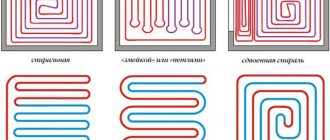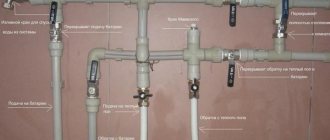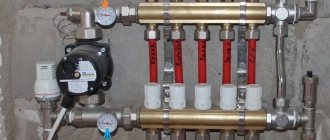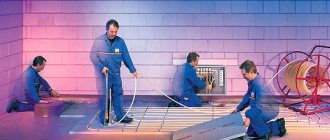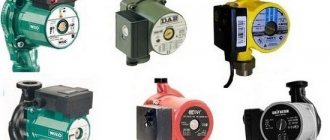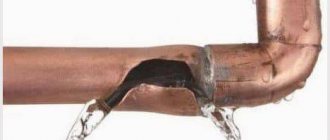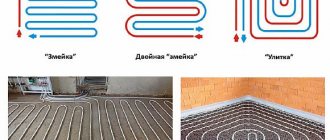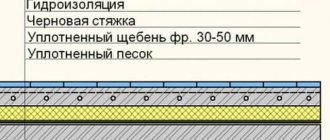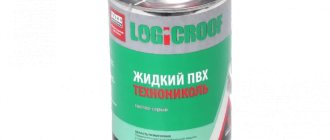The temperature of warm water floors should always create comfort in the room. This heating system is increasingly gaining popularity in the market. Thanks to it, heat is evenly distributed between the floor and ceiling, and the humidity level is always optimal.
Warm floors are easy to install and have a long service life. Experts believe that the optimal water temperature in the pipes should be 40C, so that the floor does not absorb excess electricity.
In this article we will look at information about what the optimal temperature for heated floors should be. We will also consider the recommended temperature for different floor coverings.
Temperature of the coolant in the heated floor
The most comfortable conditions for a person are considered to be when the floor surface temperature is 22-25°C, and the air heating at head level is 19-20°C.
Sanitary standards limit the air temperature: in residential premises - 18-24ºС (optimal 20-22ºС), in bathrooms and toilets - 18-26ºС (optimal 24-26ºС), in lobbies, storerooms and staircases - 12-22ºС (optimal 16-18ºС).
In the designs of underfloor heating systems, in particular water heated floors (WHF), the distribution and transfer of thermal energy occurs, which depend both on the thermal load and on the parameters of the heating panel (thermophysical and geometric), the diameter of the pipes of the heated floor circuits, and their material and laying step, finishing coating material, type of coolant, flow meter settings, etc.
As is known, for each unit of temperature difference (between the value of the floor surface and the air), the heat transfer from one square meter of the VTP heating panel is 11 W. In this case, about 45% is transferred due to heat exchange by convection, and approximately 55% - due to radiation.
Thus, to ensure an air temperature of 20°C at a maximum comfortable value of 29°C, the heating load that can be removed from the surface of the HTP will be about 100 W/m².
In most cases, the energy requirement is covered by the effective heat transfer of the surface equal to 80 W/m², however, in order to make calculations based on this value, the building must comply with thermal protection standards.
At the same time, the external walls of buildings in which the installation of high-temperature heating elements is expected must have a recommended heat transfer coefficient k<0.35 W/m² ºС (for windows, a coefficient k<2.0 W/m² ºС is recommended).
When using underfloor heating systems, it is necessary to remember to limit the temperature of the floor surface.
The optimal temperature is 24-26ºС and to ensure thermal comfort according to sanitary standards it should not exceed: 29ºС for residential and office premises where people stay permanently, 35ºС around the perimeter for the border zone along the outer wall, 33ºС for kitchens and bathrooms, 27ºС in service rooms and work areas where people work while standing.
When calculating and designing the system, it is necessary to take into account the permissible floor temperature for a particular location and length of the circuits, pipe laying pitch, flow rate and heating of the coolant.
It should be remembered that the maximum permitted coolant temperature for the HTP is 55ºC (recommended 45°C), and the difference in the forward and return pipelines of the heated floor circuit should be 5-10°C (in practice, about 7°C).
The laying step is a calculated value, but in any case should not exceed 30 cm, otherwise uneven heating of the floor surface will occur with the appearance of warm and cold stripes. To prevent the effect of a “temperature-striped floor” from being perceived by a person’s foot, the maximum temperature difference along the length of the foot should not exceed 2°C.
There are several methods for regulating the temperature of the coolant. If we consider the HTP as the main heating system and do not take into account the rooms where it is essential to maintain constant heating of the floor, then the main methods of adjusting the heat are the following:
- Variation of feed heating at constant flow depending on internal temperature.
According to some experts, the best way is to control internal heat. The reason is that most buildings have a very high thermal inertia. This means that rapid changes in outside temperature affect the inside temperature very slowly.
In other words, controlling the internal temperature is in harmony with the thermal inertia of the house. When using this control method, the risk from the influence of peak values on the internal climate of the room is minimal.
- Variation of supply heating at a constant flow depending on the outside temperature.
A number of experts, on the contrary, believe that the best way to regulate is to control the outside temperature. The reason is that in this case it is possible to work with pre-calculated curves depending on the heating of the supply water on the outside temperature.
The main advantage is that when the outside temperature rises, the control system immediately reduces the heating of the supply water, minimizing unwanted heat loss. On the other hand, a decrease in outside temperature always causes an increase in heating of the supply water
- Variable flow at constant supply water temperature.
Some experts consider the most modern way to regulate microlimate to be the use of a variable flow of supply water at a constant temperature.
Typically, the heat lost is estimated by measuring the difference between the supply and return water in the heating system. A large temperature difference indicates low heat transfer and, therefore, a small difference indicates high heat transfer.
Each of these methods has its supporters and opponents, however, in our opinion, to ensure good regulation of the internal climate, their combined use is optimal.
If you use HTP not only for heating, but also for cooling rooms, then from the point of view of energy efficiency it is important that the temperature levels of the heating and cooling systems form a unified whole, and do not compete with each other.
Here, the most effective would be the use of weather-dependent control, capable of turning off one system and turning on another depending on a certain level of outside temperature.
Water heated floors from the Atmosphere Heat company
Water heated floors are an effective solution to the heating problem. Currently, it is the best home heating system for Russia in terms of comfort and efficiency (at current energy prices). But this is also the most complex engineering network from the point of view of selecting optimal parameters and installation (creating a multi-layer screed, sealing pipe joints, installing valves and the need to regulate them, etc.)
has 10 years of experience in creating turnkey water heated floors, starting from the project and ending with commissioning. Based on it, we can guarantee:
- creation of an efficient and economical heating system;
- favorable rates for labor and materials;
- short creation time;
- provision of warranty obligations specified in the contract.
Contact a proven, experienced contractor who guarantees quality and is responsible for his work.
Maximum temperature of warm water floors
The concept of permissible temperature is defined in SNiP41-01-2003 “Heating, ventilation and air conditioning”. According to it, the maximum heating of a water heated floor cannot exceed 26 °C in those rooms where people are present all the time.
If the maximum temperature of the coolant in a warm water floor is 55 degrees, then this provides comfortable floor heating of 28 °C. It would not be superfluous to take into account the specifics of the floor covering. They can withstand 27 °C, but if the floor has been varnished, then you cannot cross the line of 21 °C. If there is a carpet on the floor, you will have to add about 5 °C.
According to health standards, if in rooms where people are constantly there should be 26 ° C, then in wet rooms it is already 31. The same temperature must be provided in those rooms where people stay for some time, and not constantly. Above the axis of the pipe it should be 35 °C, and on a parquet floor the maximum is indicated at 27 °C.
Temperature on different floor coverings
Which floor coverings to choose so as not to make a mistake? After all, it is necessary not only to maintain a comfortable temperature, but also to ensure safety for your own health.
Let's look at the main materials most often used for finishing the floor.
- When choosing laminate as a finishing floor, you need to take into account its features. Laminate boards can be laid when the heating elements of the heating system are installed evenly over the entire area of the room, and the heating temperature is not higher than 27 - 30 degrees. When purchasing such material, you should choose a class of 32 and above, with an optimal board thickness of 8 - 10 mm. The manufacturer puts a mark on the packaging of the material confirming the combination of the laminate with a heated floor.
- Linoleum and vinyl-based coatings are elastic and resistant to water. For heated floors, it is best to use thin materials that do not have an insulating base. The coating will not change its properties if the optimal heating mode does not exceed 27 degrees.
- When choosing carpet for heated floors, try to purchase natural products, because heated synthetics begin to release substances harmful to the body. If there is carpet on the floor, the operating temperature of the heated floor can be raised to 30 degrees. Try to use short-pile carpet, as the length of the pile affects thermal conductivity.
- Cork has proven to be ineffective. But if your choice is in its favor, then it is best to lay a glue-free coating on the heated floor.
- Natural wood floors are heated to 27 degrees, as the wood begins to dry out in hotter conditions. In such cases, it is recommended to adjust the operation of the system so that the level is no higher than 2/3 of the total power. And remember that immediately after laying the floor, the heating is turned on gradually, the heating mode increases over several days.
The temperature of the heated floor under the laminate should be no higher than 27-30 degrees
Optimal temperature for heated floors
A water heating system, unlike electric models, requires the presence of a concrete screed, which has a higher heating rate. Therefore, before you begin to consider what the floor temperature should be based on the finishing coating, you first need to familiarize yourself with the standard coolant flow readings.
For a pleasant walk on a comfortable floor and to avoid deformation of the concrete screed with pipelines, the maximum temperature of the coolant at the entrance to the heating system should not exceed - + 60 degrees.
The optimal value of the supply fluid flow is considered to be + 40 - + 50 degrees. The temperature difference between the coolant for the heated floor and the return should vary between 5 - 15 degrees. If these standards are not observed, problems with coolant pressure may also arise.
To ensure that heated floors are comfortable and bring pleasure and not harm (and if they overheat, this is also possible, because too high an air temperature can lead to fatigue and overheating of the body), we recommend keeping the following points in mind.
The heating core of the heating cable can heat up to 60-70°C. Heating of the floor itself can reach 35-40°C. At the same time, it is usually not a good idea to heat the floor to the highest possible temperature.
This is due to the physiological characteristics of human tactile sensations. When the surface temperature is above approximately 31°C, the heat is no longer felt as comfortable by the foot.
- According to SNiP 41-01-2003, clause 6.5.12, it is recommended that the average floor temperature does not exceed:
- 26°C for rooms with constant occupancy;
- 31°C for rooms with temporary occupancy and bypass paths of swimming pools;
- the temperature of the floor surface along the axis of the heating element in children's institutions, residential buildings and swimming pools should not exceed 35°C;
- for children's institutions and premises with permanent residence of children, including preschool institutions, according to Sanitary Norms and Rules (VSN-49-86), the recommended heating of floors is not higher than 24°C. Similar rules apply abroad.
It is in order to prevent overheating of floors that most thermostats (temperature regulators) limit the upper temperature to 40°C. Note, by the way, that the parameter monitored by the temperature sensor corresponds to the temperature at the place of its installation.
With a thick screed, it may differ from the temperature on the floor surface (on the surface, as a rule, it is slightly lower). Therefore, by the way, it is recommended to install the sensor as close to the floor surface as possible. The use of cable heating systems without thermostats using, for example, simple switches, is generally prohibited by VTTKSO.
If you have any doubts that the floor heating corresponds to what you set on the thermostat, you can check this using, for example, an infrared thermometer. If the heated floor does not heat or heats poorly (it begins to heat up much less than it was before), the floor temperature sensor may be faulty.
The materials from the underfloor heating repair section will help you independently determine the cause and eliminate it. If you do not have sufficient skills, we recommend that you seek advice from us, see underfloor heating repair: faults and cost.
A separate issue is the temperature of the floor with coatings such as parquet and laminate. The use of heated floors in this case requires greater caution and is not always advisable, because the same parquet feels much warmer than ceramic tiles.
It is also necessary to take into account that when heated to about 30°C, ordinary parquet may experience destruction of the varnish coating and deformation, which will never happen if you have installed a heated floor under the tiles. It is possible to lay heated floors under laminate; this applies primarily to film floors, limiting their temperature to 27 - 29°C.
At the same time, it is necessary to consult with the seller whether a specific laminate or parquet board is suitable for use with heated floors and to clarify the maximum temperature that should be targeted when using a specific floor covering.
Established standards for the surface temperature of underfloor heating
The reference book of Construction Norms and Rules (SNiP) establishes strict regulations on what the floor temperature should be. According to clause 44-01-2003, the maximum and minimum parameters for heated floors should be in the range of 26 and 35 °C.
The minimum point of 26 °C should only be set if there are always people in the room. If visitors rarely enter the room, then the optimal temperature should be at 31 °C.
This value is usually set for bathrooms, swimming pools and toilets, where a comfortable temperature for the feet is most necessary.
The main limitation is that the temperature along the heating axes should not exceed the permissible 35 ° C; a higher temperature will cause unwanted overheating of the system and the floor covering.
Values of a floor temperature made of various materials that is comfortable for a person in a standing position (in a sitting position, people prefer temperatures 1 ° C - 2 * C higher) depending on the time of contact
| Floor construction (thickness) | Heat loss kJ/m2 | Optimal floor temperature °C | Recommended floor temperature range °C | |||
| 1 min | 10 min | 1 min | 10 min | 1 min (10% dissatisfied) | 10 min (15% dissatisfied) | |
| Textile covering | 17 | 75 | 19 | 24 | 8 — 30 | 20 — 28 |
| Fluffy (velvet) carpet | 20 | 91 | 21 | 24,5 | 12 — 30.5 | 21 — 28 |
| Sisel carpet | 14 | 123 | 23 | 25 | 15.5 — 31 | 22.5 — 28 |
| Non-woven covering | 21 | 111 | 22 | 25 | 13 — 30.5 | 22 — 28 |
| Cork floor (5 mm) | 26 | 145 | 24 | 26 | 17 — 31 | 23 — 28 |
| Pine plank floor | 29 | 124 | 2S | 25 | 18.5 — 31 | 22.5 — 28 |
| Oak plank floor | 36 | 182 | 26 | 26 | 21.5 — 31.5 | 24.5 — 28 |
| Wooden floor | 38 | 134 | 26,5 | 25,5 | 22 — 31.5 | 23 — 28 |
| Vinyl asbestos tiles | 80 | 485 | 30 | 28,5 | 28 — 32.3 | 27.5 — 29 |
| PVC covering with felt base | 49 | 242 | 28 | 27 | 24.5 — 32 | 25.5 — 28 |
| PVC covering (2 mm) | 60 | 36S | 29 | 27,5 | 26 — 32 | 26.5 — 28.5 |
| Mosaic floor (S mm) on foam concrete | 60 | 301 | 29 | 27 | 26 — 32 | 26.5 — 28.5 |
| Mosaic floor (6 mm) on cork (20 mm) | 63 | 211 | 29 | 26,5 | 26.5 — 32 | 25 — 28 |
| Hard linoleum (2.5 mm) not wooden floor | 46 | 176 | 28 | 26 | 24 — 32 | 24 — 28 |
| Hard linoleum (2.2 mm) on concrete | 45 | 296 | 28 | 27 | 23.5 — 32 | 26 — 28.5 |
| Painted concrete floor | 77 | 467 | 30 | 26,5 | 27.5 — 32.5 | 27.5 — 29 |
| concrete pop | 50 | 298 | 28,5 | 27 | 24.6 — 32.0 | 26 — 28.5 |
| Marble | 7S | S11 | 30 | 29 | 27.5 — 32.5 | 28 — 29.5 |
| Concrete slabs finished with steel trowel | 63 | 475 | 29 | 28,5 | 26.5 — 32 | 27.5 — 29 |
| Concrete slabs finished with wooden trowel | 60 | 419 | 29 | 28 | 26.0 — 32 | 27 — 29 |
For a parquet surface, the maximum value is 27 °C. This is caused by the characteristics of the material and its thermal properties; overheating of such a floor covering can lead to its deformation.
For a comfortable stay in the room, 22-24 °C is enough. This temperature is pleasant for the feet and evenly heats the air in the room. Unlike classic batteries, air heating will be maximum over the entire height of the area. In practice, a coolant value of 30 °C is rarely achieved.
As a rule, all parameters are calculated at the design stage of the heated surface. Before installing water and electric heating systems, their tasks and room heat loss indicators should be taken into account.
Heating speed of heated floors
- According to their characteristics, heating systems can be divided into two types:
- Water, where the coolant function is performed by water, antifreeze or ethylene glycol solutions.
- Electric, where carbon rods, electrical cables or infrared film act as the coolant.
Each system has its own advantages and disadvantages. The heating time of such floors depends on the design of the coolants and the depth at which they are laid.
To heat one square meter of surface with a screed depth of 5 - 6 cm, an average of 1.5 - 2 hours is required.
A water heated floor takes a long time to warm up. The heating time can be 20 - 30 hours; the rise in temperature for the feet will be noticeable after about 5 hours. Most of the time and energy is spent on heating the screed, which on average reaches a thickness of 5 cm.
Only after it is heated does heat transfer into the room. After switching off, a comfortable temperature of the surface and room can be maintained throughout the day. As a rule, the total heating and cooling time depends on the thickness of the tie elements. A significant disadvantage of such a coolant is the difficulty of installation.
Heating speed and temperature conditions
Due to their characteristics, heating systems are divided into two main types:
- water - the heat carrier is water, ethylene glycol solutions, antifreeze;
- electric - heat is generated by carbon rods, electrical cables, infrared film.
Each system has its positive aspects and negative aspects. The heating time of heated floors in each case depends on the design features of the thermal fluid and the depth of its installation. For example: to warm up a square meter of floor, the screed depth of which is 5–6 cm, it will take from one and a half to two hours.
Water floor
The system heats up for quite a long time, about two to three dozen hours. An increase in temperature at the level of the feet will begin to be felt in about five hours. A lot of time and thermal energy will be required to warm up the screed, the average thickness of which is 5 cm. As soon as this layer heats up, heat will begin to flow into the room. By turning off the system, you can feel the comfortable temperature of the heated floor for another day. The water system has one drawback associated with the complexity of installation work.
Electric floor
With the help of such systems, heating of the floor surface occurs quickly, since the coolant instantly warms up, spending no more than six to eight minutes. Next, he evenly heats the screeds around the perimeter of the room. The time required to reach the set temperature parameter ranges from twelve hours to one day - depending on the volume of the heated room. You will feel warmth near your feet within a couple of hours. When the power is turned off, the cable underfloor heating system can maintain the set mode for a long time. The design has a thermoregulatory device, which, when the heat drops by two to three degrees, automatically starts the heating system into operation.
Infrared floor
The innovative and fastest heating systems are rod and film infrared. The peculiarity is that heat transfer is carried out by direct radiation. From the first hours of operation, an increase in the air temperature in the room is noticeably felt. Heat is supplied directly to the room; time and energy are not wasted on heating the screed and floor covering. It should be noted here that for such systems a screed of minimum thickness is arranged. No more than ten minutes pass from the first switch-on, and the system reaches its nominal operating mode, starting to heat the entire room.
It is necessary to ensure that infrared coolants do not overheat above thirty degrees, otherwise they will simply fail.
Comfortable floor temperature
For some this may be a discovery, but the warm floor is practically not felt by the feet. In the literal sense of the word. You can walk barefoot on the floor, waiting for me to feel this warmth and experience all the charm of heated floors. But it was not there.
Adequate heating of the surface of a water heated floor does not exceed 28 degrees. This is why it is difficult to feel anything with your feet. Body temperature is simply higher. And all you experience is comfort from the fact that your feet are not cold.
In this case, the heating of the coolant on the boiler usually does not exceed 45 degrees. Of course, the numbers are not absolute and there are adjustments up and down. An important parameter of this type of system is the temperature of the system and coating.
Of course, each variety has certain indicators, but standard limits are determined by SNiP. This document clearly regulates the maximum and minimum temperatures of the floor covering. It can vary between 26-35 degrees.
- Taking into account the physiological characteristics of a person, the floor temperature should not exceed the following limits:
- 29 degrees (with an optimal 26) – corridors, hallways, kitchens, living rooms. In bedrooms, children's and playrooms, the temperature should be several degrees lower, due to operating conditions.
- 34 degrees – floor in the bathroom and toilet;
- 35 degrees – for places characterized by high heat loss (windows, perimeter along external walls).
Heating the floor to this value allows you to ensure a room temperature of 20 degrees for residential premises, and 24 for rooms with a high level of humidity (bathroom). Experts recommend keeping the floor surface heating at 26 °C in high-traffic areas.
If the room has low traffic, then it is advisable to raise the temperature to 31 °C. The main limitation specified in the regulatory documents is maintaining the temperature along the heating axes. It should not exceed 35 °C, otherwise the system itself and the floor covering will overheat.
In the case of overheating, not only the system suffers, but also the person, since walking on a surface that is too warm is unpleasant. In addition, temperature fluctuations in high ranges can lead to damage to the integrity of the floor covering. For each type of finish, certain limits are recommended, exceeding which is undesirable.
Why is your temperature so much higher?
Quite often it happens when the heating of the coolant in the boiler reaches 60-70 degrees. In this case, the floors may be barely warm. This is primarily due to an incorrectly installed system.
In this situation, there can be three reasons:
- The most common. They did not install proper thermal insulation or used an option that was too thin. Because of this, part of your heat goes down and you are forced to “stoker” to high temperatures in order to somehow feel the warmth.
- Less common. Warm floors were installed with a large laying step and this prevents the house from warming up.
- The heat loss of your home exceeds that for using water heated floors. Therefore, you cannot warm up the house.
There are also cases when the temperature of the water heated floor on the surface, on the contrary, is too high. And if you lower it, it becomes cold. Here, as an option, you can sin on the fact that you poured a fairly thin screed and it simply does not accumulate enough heat.
- Here are some recommendations for installing a water-heated floor that will allow you to avoid problems with incorrect temperatures:
- Use good thermal insulation. Expanded polystyrene with a thickness of at least 5 cm.
- Fill the screed with a height of 5 cm from the surface of the pipe.
- Use a step of 15 cm in the main areas, 10 cm in the edge areas.
- Make a heating project and install the system according to it. Then you definitely can't go wrong.
Temperature adjustment
- Temperature adjustment:
- Add a thermostat. Mount it on the manifold. Use pipes with an operating temperature of 95 degrees, because the heating of the water heated floor in the supply will be high.
- It can be adjusted using a three-way valve.
- Using a mixing module or another mixing module.
- Using room thermostats and servos on the manifold.
To create comfortable conditions, as well as save resource consumption, special devices are provided that allow you to regulate and control the temperature of the heated floor. Types of adjustment should be considered within each individual system.
Water systems are equipped with thermostatic valves or pumping and mixing groups with automatic control. Their use eliminates the possibility of overheating of the floor covering.
In addition, they are able to respond to changes in temperature in the room and close or open valves to maintain the optimal heating level.
- Adjustment of infrared and electric floors. To monitor the temperature and regulate it, the following devices are provided for such systems:
- electromechanical regulators;
- digital devices;
- programmable devices.
The system complex includes not only a regulator, but also special sensors that monitor changes in the heating mode. For safety, they have a shutdown function that is activated when the system reaches the maximum temperature limit.
When the temperature drops, they turn on again. Such a system is energy efficient, because it allows you to save about 40-50% of consumed resources.
What should be the optimal one?
Optimal temperature indicators for different types of premises are defined in GOST 30494-96 “Residential and public buildings. Indoor microclimate parameters." This regulatory document contains the following information:
- In living rooms, a comfortable temperature for living should be from 20 to 22 degrees Celsius.
- In the kitchen and toilet it is necessary to ensure the temperature within 19-21 degrees Celsius.
- In the bathroom or combined bathroom, it is recommended to maintain a temperature of 24 to 26 degrees Celsius.
- In the corridor, a microclimate should be ensured at 18-20 degrees Celsius.
Healthy
The optimal temperature of a warm water floor required to maintain the above indicators and comfort of the feet is 27-28 degrees.
If there are rarely people in the room, it can be increased to 31 degrees. The main thing is that it provides the above-mentioned recommendations from specialists in relation to the temperature indicators of rooms with different purposes.
Automation for underfloor heating: control of underfloor heating system devices
Let's look at the diagrams to see how automation for heated floors is connected and which devices can be controlled automatically.
Let’s clarify right away: the principles of using automatic devices are the same for both radiator heating and water heated floors (as well as for heating with warm walls and baseboard heating - if you were looking for something about them).
Automation for underfloor heating can control the following devices: circulation pump, servo drives, thermostatic heads and thermostatic valves, gas burner.
Circulation pump control
This is the simplest type of control: depending on the temperature of the coolant, the pump will turn on/off.
To implement this method you do not need a lot of knowledge or special qualifications. And the “automation for heated floors” is not used here: it’s just a room thermostat and nothing more.
The circulation pump control diagram looks like this:
As you can see, there is a thermostat installed in any room; when the set temperature is reached, the thermostat operates and turns off or turns on the pump.
This is how you can easily control the floor temperature automatically:
Here the thermostat monitors the readings of a sensor mounted in the floor between (and not on one pipe!) the pipes. The sensor gives a command to the thermostat, which processes the received signal and turns the circulation pump on/off.
Disadvantage: if there is one common pump for the whole house, then this method is not always suitable, because the pump is turned off by a thermostat installed in one room, and when the pump is turned off, the heating will stop throughout the house. This method is suitable if there are two pumps, for example, on different floors, and you need to control the heating on one floor without touching the second.
Thermal head control
Let's say there is a mixing unit with a three-way valve in front of the manifold:
A thermal head is screwed onto this valve, to which a temperature sensor is connected. The sensor is installed on the pipe in which we want to control the temperature (it can be directly on the supply or return manifold). And we set the temperature we need on the thermal head. Now, based on a signal from the sensor, the thermal head will close or open the three-way valve, thereby adjusting the temperature of the coolant to, again, the desired parameter.
Control of servos with floor sensor
A servo drive is installed on the collector on each circuit and, depending on the floor sensor or thermostat, the coolant supply is adjusted in individual circuits:
This is a good way to set the temperature individually for each room.
Three way mixing valve control
It has already been said above that the three-way valve is part of the mixing unit. In the following diagram it (the valve) is on the return line:
The three-way valve in this diagram is equipped with a servo drive, which is controlled by the temperature sensor and thermostat.
Weather-compensated room temperature control
This is automatic control of the heating system depending on the outside air temperature.
Controllers are installed here, in which a specific program is embedded:
Depending on the outside temperature, the controller maintains the desired operating mode of the heating system, controlling all the same devices discussed above. This control method achieves significant gas savings: 20...30 percent.
In fact, in a private home there is no need for any sophisticated automation for heated floors. If you make automation only for the circulation pump, then that will be very good.
Comfortable temperature in the rooms of a private house.
I would never have thought that a person’s comfortable temperature lies in such a narrow range.
Until I started using thermostats.
Although we lived without thermostats before and did not grieve.
| It turned out that at 21.5 degrees you want to add heating, and at 23 you want to turn it down. It is believed that at night, during sleep, the temperature should be low. During the day, when most likely no one is at home, there is also no need to heat it to 22 degrees. Of course, such desires arise when there is a way to put them into practice. Actually, this is what weekly room thermostats are for. |
In new programmable weekly room thermostats, the night temperature is factory set to 16 degrees.
This is probably how it is done in China. I can’t imagine anyone in Russia sitting at +16 degrees if there is a thermostat with a “+” button.
It's another matter when there is a child in the house. And when the house has laminate floors on screed and no carpets.
In the interior hallway I have linoleum, and there are no heated floors, and no carpets. And nothing. There is no desire to install a carpet. The screed placed on a layer of polystyrene does not cool down much.
But there are other rooms around this room and no one sits on the floor in it.
In residential premises, using laminate flooring on concrete would not be very pleasant.
Floors with laminate on screed must be heated.
